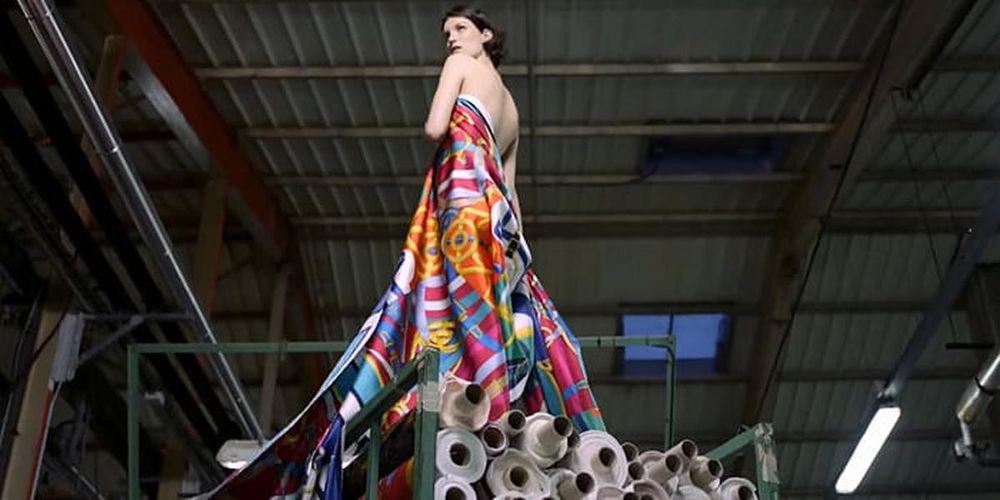The Secrets of Making an Hermès Carré
Charmaine Ho travels to Lyon, France, to discover the magic that’s woven into Hermès’ beloved silk scarves

It has been tied around the necks of numerous celebrities and twirled around countless Birkin straps. But what springs to my mind when the words “Hermès Carré” are uttered is a charming story told by a taxi driver when I was in Geneva one cold and wet January night. He recalled the half-francs his two young children had squirrelled away just to buy their mother an Hermès silk scarf for her birthday.
“Were their savings enough for the scarf?” I asked, trying to imagine the number of half-francs it would take to meet the scarf’s price tag. “Of course not!” came the reply. “I had to pay for 95 percent of it. But the joy on her face when she opened the present was worth the money.”
Earlier this June, I find myself thinking about the story once again as we make our way from the airport to Hermès’ silk workshop, located a 20-minute car ride away from Lyon, the silk capital of France. However, it isn’t until I’ve entered the hallowed halls of Holding Textiles Hermès (HTH); the place where much of the magic takes place) that I realise the role that it has to play in the legend that surrounds the Hermès Carré. We are, after all, talking about a square piece of fabric that has managed to distinguish itself as an object of utmost luxury and desire, in a market filled with a sea of silk scarves. How else could it have attained the reputation of being a beloved sartorial treasure—one that reportedly sees worldwide sales every 20 seconds—except through stories like these?
Related article: Paris Fashion Week: 10 Best Looks from Hermès Spring/Summer 2019
Storytelling is a big part of what makes an Hermès scarf so special; it’s woven into its very fabric, reinforced with vibrant, flat-screen printed designs. And with about 10 new creations being launched each season—each telling a tale that’s as unique as the personalities that breathed life into them; and subjects that range from the abstract to zoology, fantastical to realist —that’s an anthology of about 2,000 stories that have been told since the Carré was first introduced in 1937.
As I soon find out, even the making of its silk is a tale of love and romance: The coupling of each pair of Bombyx Mori silk moths results in 300 eggs and, consequently, cocoons. From each cocoon comes a single, unbroken 1,500m-long silk strand. Multiply that by 300 and you have 450,000m of silk—which is just the amount needed for a 90cm Carré. Thus, you could say that each scarf was created out of love from a pair of silk moths on one fateful night in Brazil, where Hermès gets its silk. It’s a lovely
story, but not any more wonderful than the story of collaboration that aerates each scarf.
Related article: An Exclusive Look Inside The Hermès 'Avec Elle' Exhibition in Tokyo
Hermès relies on a global team of approximately 50 independent, freelance designers (including, famously, Kermit Oliver, a 76-year-old postman from Waco, Texas) to dream up its prints. Once a design has been chosen for production, it gets scanned into a computer where an artist outlines the design on a screen. This is then sent to the colour department, where 15 different colourways are conjured up (out of which, eight to 10 will make it to the stores), using colours that it has specially mixed or ones taken from its library. At each step of the way are people who have imparted their artistic vision and expertise to the final result, weaving a little bit of their talent into the scarf’s four corners.
Yet, for all the wonderful narratives that the silk evokes, it is the unparalleled and tangible quality immediately felt that truly sets the Hermès Carré apart. From the reassuring weight of its silk (only the highest grade of silk, 6A, is used for its strength and thickness), to the six-month engraving process that sees every dot and dash of its design being meticulously transposed from paper to silk, to its hand-rolled French hems of 15mm (no more, no less) and 90-degree corners, every step is carried out with the utmost care and devotion, resulting in a labour of love that takes two years in the making. Now that’s an unforgettable tale that lasts a lifetime.
Related article: Inside the Hermès Fall/Winter 2018 Show